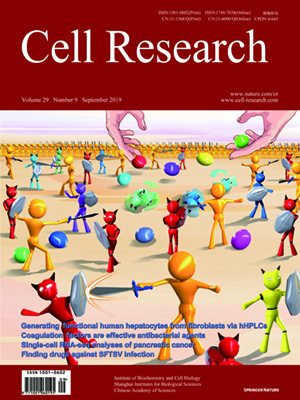
Volume 29, No 9, Sep 2019
ISSN: 1001-0602
EISSN: 1748-7838 2018
impact factor 17.848*
(Clarivate Analytics, 2019)
Volume 29 Issue 9, September 2019: 711-724 | Open Access
ORIGINAL ARTICLES
Coagulation factors VII, IX and X are effective antibacterial proteins against drug-resistant Gram-negative bacteria
Jinwu Chen1, Xiaojie Li1, Ling Li 1,2, Ting Zhang1, Qing Zhang1, Fangming Wu3, Diyue Wang1, Hongze Hu4, Changlin Tian 3,5 ,Dongsheng Liao1, Liang Zhao1, Danxia Song1, Yongyun Zhao1, Chuanfang Wu1 and Xu Song 1,2
1Center for Functional Genomics and Bioinformatics, Key Laboratory of Bio-Resource and Eco-Environment of Ministry of Education, College of Life Sciences, Sichuan University,
Chengdu 610064 Sichuan, China; 2State Key Laboratory of Biotherapy, West China Hospital, Sichuan University, Chengdu 610041 Sichuan, China; 3High Magnetic Field Laboratory, Chinese Academy of Sciences, Hefei 230031 Anhui, China; 4CAS key Laboratory of Soft Matter Chemistry, Department of Chemistry, University of Science and Technology of China, Hefei 230026 Anhui, China and 5Hefei National Laboratory for Physical Sciences at the Microscale and School of Life Sciences, University of Science and Technology of China, Hefei 230026 Anhui, China
Correspondence: Xu Song (xusong@scu.edu.cn)These authors contributed equally: Jinwu Chen, Xiaojie Li, Ling Li, Ting Zhang, Qing Zhang
Infections caused by drug-resistant “superbugs” pose an urgent public health threat due to the lack of effective drugs; however, certain mammalian proteins with intrinsic antibacterial activity might be underappreciated. Here, we reveal an antibacterial property against Gram-negative bacteria for factors VII, IX and X, three proteins with well-established roles in initiation of the coagulation cascade. These factors exert antibacterial function via their light chains (LCs). Unlike many antibacterial agents that target cell metabolism or the cytoplasmic membrane, the LCs act by hydrolyzing the major components of bacterial outer membrane, lipopolysaccharides, which are crucial for the survival of Gram-negative bacteria. The LC of factor VII exhibits in vitro efficacy towards all Gram-negative bacteria tested, including extensively drug-resistant (XDR) pathogens, at nanomolar concentrations. It is also highly effective in combating XDR Pseudomonas aeruginosa and Acinetobacter baumannii infections in vivo. Through decoding a unique mechanism whereby factors VII, IX and X behave as antimicrobial proteins, this study advances our understanding of the coagulation system in host defense, and suggests that these factors may participate in the pathogenesis of coagulation disorder-related diseases such as sepsis via their dual functions in blood coagulation and resistance to infection. Furthermore, this study may offer new strategies for combating Gram-negative “superbugs”.
https://doi.org/10.1038/s41422-019-0202-3
FULL TEXT | PDF
Browse 1301


